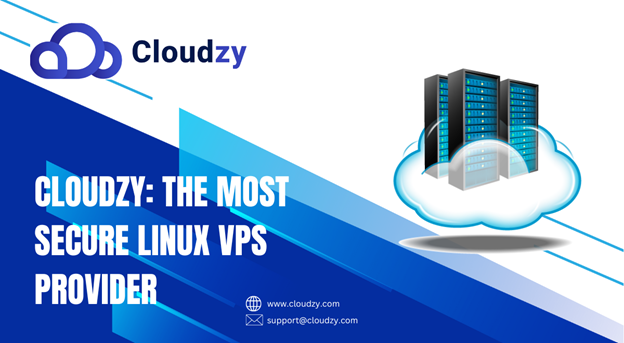Securing your Linux Virtual Private Server (VPS) is essential for protecting your data and maintaining the integrity of your applications. According to CyberNews, Cloudzy is recognized as one of the most secure VPS providers, offering a range of operating systems, including Windows VPS, Linux VPS, and Ubuntu VPS. Cloudzy has implemented multiple security measures to safeguard users’ data and ensure a secure hosting environment. In addition to its robust security protocols, Cloudzy provides numerous benefits that enhance performance, such as a diverse network of data centers around the world, various payment options, and tailored solutions for traders, gamers, and small to medium-sized businesses.
Here are ten effective strategies to enhance the security of your Linux VPS.
Why Cloudzy is the Most Secure VPS Provider
Cloudzy prioritizes security by integrating various advanced practices.
- MISP Integration: The company uses the Malware Information Sharing Platform (MISP) to efficiently gather and analyze threat intelligence. This allows for real-time insights into emerging cyber threats by correlating data from multiple sources, including social platforms.
- CrowdSec Threat Intelligence: Cloudzy employs CrowdSec, a community-driven system that enhances threat detection through collective intelligence, improving their ability to respond to cyber threats.
- Dedicated Malware Analysis Team: A specialized team analyzes suspicious files and activities, using sandboxes to safely examine malware behavior. This analysis informs the development of effective countermeasures against threats.
- ThreatFox and URLScan Data: Cloudzy integrates ThreatFox and URLScan data to identify and block malicious indicators and harmful websites, enhancing their threat intelligence capabilities.
- Advanced Network Monitoring: The provider utilizes advanced network monitoring tools for real-time detection of anomalies and potential security incidents, allowing for swift threat responses.
- Continuous Security Updates and KYC: Cloudzy continuously updates its security measures and has implemented Know Your Customer (KYC) protocols to enhance user verification and prevent fraud.
- Collaboration with Recorded Future: Their partnership with Recorded Future has significantly improved their threat intelligence capabilities, enabling better defense against emerging threats. CEO Hannan Nozari highlights the importance of collaboration in maintaining cybersecurity vigilance.
Overall, Cloudzy’s comprehensive security strategies position it as a leading VPS provider in terms of safety and reliability. If you are unsure whether Cloudzy meets your needs, consider reading Cloudzy reviews.
10 Ways to Secure Your Linux VPS
1. Keep Your System Updated
Keeping your Linux VPS updated is one of the simplest yet most effective ways to enhance its security. Software, including operating systems and applications, can have vulnerabilities that attackers may exploit. Developers regularly monitor their software for bugs and weaknesses, and when they discover these vulnerabilities, they release updates or patches to fix them. If you neglect to apply these updates, your system remains exposed to potential attacks, putting your data and applications at risk.
Regular updates not only address security flaws but also improve performance and stability. Many applications rely on various libraries and frameworks, which can also have their own vulnerabilities. By updating your system, you ensure that all components of your software stack are secure and functioning well together. Additionally, staying updated is often a compliance requirement in many industries, as it helps protect sensitive information and meets regulatory standards.
Most Linux distributions provide tools that can automate the update process, allowing you to schedule updates to occur regularly without manual intervention. This convenience helps you maintain a secure environment with minimal effort. It’s advisable to check for updates frequently, at least once a week, and to pay attention to notifications regarding important security updates. If possible, testing updates in a staging environment before applying them to your production server can further safeguard against potential disruptions.
2. Use SSH Key Authentication
Using SSH key authentication is another highly effective way to secure remote access to your Linux VPS. Unlike traditional password-based authentication, which relies on a user entering a password to gain access, SSH key authentication uses a pair of keys: a public key and a private key. The public key is placed on the server, while the private key remains securely stored on your local machine. This method is significantly more secure because SSH keys are much harder to crack than conventional passwords, which can be weak or easily guessed.
When you attempt to connect to your VPS, the server checks for the corresponding public key associated with the private key on your local machine. If they match, access is granted without the need for a password. This eliminates risks associated with weak passwords, such as those being easily cracked through brute-force attacks, where an attacker tries numerous password combinations to gain access. With SSH keys, even if an attacker knows the username, they would still need the private key, which is much less likely to be compromised.
Setting up SSH key authentication involves generating a key pair using tools like ssh-keygen and then copying the public key to your VPS. Once configured, you can disable password authentication altogether, which further enhances security by preventing unauthorized login attempts. This method not only provides a stronger defense against potential attacks but also streamlines the login process, as you won’t need to enter a password every time you connect. Overall, using SSH key authentication is a robust strategy for securing remote access to your server, significantly reducing the risk of unauthorized access and enhancing your VPS’s overall security posture.
3. Change the Default SSH Port
Changing the default SSH port from 22 to a less common port is an effective strategy for enhancing your server’s security. The standard port 22 is widely known and frequently scanned by attackers looking for vulnerabilities in SSH services. By changing the port number, you can significantly reduce the number of automated attacks that target your server, as many attackers rely on default settings when scanning for potential weaknesses.
When you alter the SSH port, you add an additional layer of obscurity to your server’s security. While this does not eliminate the risk of targeted attacks, it complicates the process for potential intruders. Most automated tools used by attackers are programmed to look for services running on commonly used ports, so moving SSH to a different port can effectively deter many opportunistic attacks. This simple change can help filter out a significant amount of malicious traffic, allowing you to focus on legitimate access attempts.
4. Configure a Firewall
Configuring a firewall is an essential step in securing your Linux VPS, as it enables you to control both incoming and outgoing traffic to the server. Firewalls act as a barrier between your server and the outside world, allowing you to define specific rules that determine which types of traffic are permitted and which are blocked. By setting up a firewall, you can effectively filter out unwanted connections, significantly reducing the risk of unauthorized access and potential attacks.
When configuring your firewall, it’s important to allow only the necessary connections that your server requires to function properly. For instance, if you need to access your server via SSH, you would permit traffic on the designated SSH port. Similarly, if your server hosts a website, you would allow HTTP and HTTPS traffic. By limiting access to these essential services, you minimize the attack surface and make it more difficult for malicious actors to infiltrate your system.
Additionally, firewalls can offer advanced features, such as logging and monitoring, which allow you to keep track of attempted connections and detect suspicious activity. This visibility can be invaluable for identifying potential threats and responding proactively. While configuring a firewall does require some initial setup and ongoing management, the benefits it provides in terms of enhanced security and peace of mind are well worth the effort. Overall, implementing a firewall is a fundamental practice for protecting your VPS and ensuring that only legitimate traffic can interact with your server.s.
5. Disable Root Login
Disabling root login via SSH is a crucial security measure for protecting your Linux VPS. The root account has unrestricted access to all system files and settings, making it a prime target for attackers. By disabling direct access to the root account, you add an additional layer of security that complicates the process for anyone attempting unauthorized entry. Instead of having easy access to the most powerful account, attackers must first guess the username and password for a regular user account before they can even think about escalating their privileges.
This additional step significantly raises the difficulty level for potential intruders. If an attacker knows the username of a regular user account, they still face the challenge of cracking the password, which can be lengthy and complex. Even if they manage to gain access to a regular user account, they would still need to execute specific commands to gain root privileges, which adds further complexity. This multi-layered approach effectively protects sensitive data and system configurations from unauthorized access.
Moreover, by forcing users to log in with a regular account, you can implement more granular security measures, such as limiting access rights and implementing user-specific permissions. This not only enhances security but also provides a more organized way to manage user access to the server. Overall, disabling root login is a simple yet effective way to bolster your server’s defenses, making it much harder for unauthorized users to gain control and compromising the integrity of your system.
6. Install Fail2Ban
Installing Fail2Ban is another effective strategy for protecting your Linux VPS from brute-force attacks, which are common methods used by attackers to gain unauthorized access. Fail2Ban actively monitors your server’s log files for suspicious activity, specifically looking for patterns that indicate repeated failed login attempts. When it identifies an IP address that has tried to connect unsuccessfully multiple times within a short period, it automatically takes action by banning that address for a pre-defined duration.
This proactive approach is crucial for enhancing your server’s security. By automatically blocking malicious IPs, Fail2Ban significantly reduces the risk of unauthorized access without requiring constant manual intervention. Legitimate users who access your server will not be affected by these bans, ensuring that they can connect without issue. The system’s automation allows you to maintain a high level of security while minimizing the administrative burden associated with monitoring login attempts.
Additionally, Fail2Ban is highly configurable, allowing you to tailor its settings based on your specific security needs. You can adjust the thresholds for failed login attempts, set different ban durations, and even configure email notifications to alert you of suspicious activity. This flexibility enables you to create a robust defense mechanism tailored to your server’s unique environment. Overall, implementing Fail2Ban adds an essential layer of protection against brute-force attacks, enhancing the security of your VPS while supporting legitimate user access.
7. Regular Backups
Implementing a regular backup strategy is essential for protecting the data on your Linux VPS. Regular backups serve as a safety net that allows you to restore your information in the event of accidental deletion, hardware failure, or even a successful cyberattack. Without a solid backup plan, you could face significant data loss, which can disrupt operations and lead to costly downtime.
By using automated backup solutions, you can streamline the backup process and ensure that your data is consistently protected without requiring manual effort. Automated backups can be scheduled to run at regular intervals—daily, weekly, or even hourly—depending on your needs. This reliability reduces the risk of forgetting to perform backups and ensures that your most recent data is always available for restoration.
In addition to creating backups of your data, it’s important to store those backups in a secure location, preferably offsite or in the cloud. This way, even if your primary server is compromised or physically damaged, you can still recover your essential files and applications. Testing your backups regularly is also crucial to ensure that they can be restored successfully when needed. Overall, a robust backup strategy not only safeguards your data but also ensures business continuity, allowing you to recover quickly from incidents and maintain operational resilience.
8. Monitor Logs
Regularly monitoring system logs is crucial for maintaining the security of your Linux VPS. Logs are valuable resources that provide detailed insights into the operations of your server, recording events such as login attempts, system errors, and application activity. By keeping a close eye on these logs, you can detect unusual or suspicious activity that may indicate potential security breaches or unauthorized access attempts.
Consistent log review allows you to identify patterns or anomalies that could suggest an ongoing attack or a system malfunction. For example, an unusually high number of failed login attempts from a single IP address may signal a brute-force attack. Early detection of such issues enables you to take timely action, such as blocking the offending IP address or investigating further to mitigate risks before they escalate.
Many Linux distributions offer tools and utilities that can help simplify the log monitoring process. You can set up automated alerts to notify you of specific events, such as repeated failed logins or changes to critical files. Additionally, using log management solutions can provide advanced analytics and visualization, making it easier to spot trends and outliers. Overall, actively monitoring system logs is an essential practice that enhances your server’s security posture, allowing you to respond swiftly to potential threats and maintain a secure environment.
9. Use Security Tools
Incorporating additional security tools into your Linux VPS can significantly enhance your overall security posture. Tools such as Lynis and ClamAV provide critical functionalities that help protect your server from various threats. Lynis is a security auditing tool that assesses your system for vulnerabilities and misconfigurations. It performs thorough checks on system settings, installed software, and security policies, offering actionable recommendations to improve your security setup. By regularly running Lynis, you can identify weaknesses before they can be exploited by attackers.
ClamAV, on the other hand, is an open-source antivirus solution specifically designed for detecting malware on your server. It scans files and directories for malicious software, helping to ensure that your system remains free from infections that could compromise your data and applications. Regular scans with ClamAV can catch potential threats early, allowing you to take corrective action before any damage occurs.
Using these security tools not only helps you identify vulnerabilities and detect malware but also allows you to maintain a proactive stance on security. Regular updates and scans ensure that you are aware of the current state of your server’s security, enabling you to respond promptly to any issues that arise. Overall, integrating security tools into your VPS management strategy is a vital practice that adds layers of protection and helps safeguard your critical data and applications from emerging threats.
10. Disable Unused Services
Disabling unused services on your Linux VPS is a crucial step in minimizing your attack surface and enhancing overall security. Every service running on your server can potentially introduce vulnerabilities that attackers could exploit. By identifying and turning off any services that are not actively being used, you reduce the number of entry points available for unauthorized access, thereby lowering the risk of an attack.
When you streamline your server’s processes by disabling unnecessary services, you not only enhance security but also improve system performance. Fewer running services mean reduced resource consumption, leading to better overall efficiency. Additionally, this practice simplifies your server management, making it easier to monitor and maintain the remaining active services.
To effectively manage your services, regularly review the list of active services on your server. Most Linux distributions provide commands to list these services, allowing you to assess which ones are essential for your operations. Once you’ve identified the unnecessary services, you can disable them to prevent any potential exploits. Overall, taking the time to disable unused services is a proactive measure that significantly contributes to the security and reliability of your Linux VPS.
Conclusion
Securing your Linux VPS is an ongoing process that requires regular attention and updates. By implementing these ten strategies, you can significantly enhance the security of your server and protect your valuable data. Remember that security is not a one-time task but a continuous effort to adapt to new threats.





